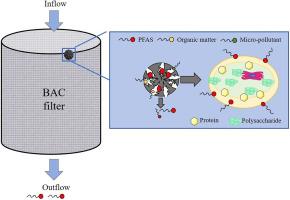Inhibitory effects of biofilms on the adsorption of per- and polyfluorinated alkyl substances by biological activated carbon in practical drinking water treatment plants
IF 6.3
2区 环境科学与生态学
Q1 ENVIRONMENTAL SCIENCES
引用次数: 0
Abstract
Although activated carbon filters are thought to be the best way to remove per- and polyfluorinated alkyl substances (PFAS), it is yet unknown how biofilms affect PFAS removal. This study first examined how the removal of PFAS in full-scale drinking water treatment plants (DWTPs) was impacted by biofilm from biological activated carbon (BAC) of varying depths and carbon ages. PFAS desorption from BAC was visible, but at this point, BAC could still remove dissolved organic matter (DOM) efficiently. Studies have demonstrated that the use of activated carbon filters can dramatically lower the content of PFAS in water, with the amount of PFAS reducing as the filter's depth grows and its use duration increases. Additionally, pore-clogging becomes more noticeable as the biofilm ages, which reduces BAC's capacity to eliminate PFAS and hinders PFAS desorption. Furthermore, the adsorption process of PFAS may be impeded by the secretion of biofilms, which are composed of proteins and polysaccharides. Based on the analysis above, it can be the adsorption of PFAS by BAC is significantly inhibited by biofilms, according to another research. This provides theoretical direction for improving the removal effectiveness of PFAS in DWTPs.

生物膜对生物活性炭吸附全氟和多氟烷基物质的抑制作用
虽然活性炭过滤器被认为是去除全氟和多氟烷基物质(PFAS)的最佳方法,但生物膜如何影响PFAS的去除尚不清楚。本研究首先考察了不同深度和碳龄的生物活性炭(BAC)形成的生物膜如何影响大规模饮用水处理厂(dwtp)中PFAS的去除。可见BAC对PFAS的解吸作用,但此时BAC仍能有效去除溶解性有机物(DOM)。研究表明,使用活性炭过滤器可以显著降低水中PFAS的含量,并且随着过滤器深度的增加和使用时间的延长,PFAS的含量会减少。此外,随着生物膜的老化,孔隙堵塞变得更加明显,这降低了BAC消除PFAS的能力,阻碍了PFAS的解吸。此外,由蛋白质和多糖组成的生物膜的分泌可能会阻碍PFAS的吸附过程。根据上述分析,另一项研究表明,生物膜明显抑制了BAC对PFAS的吸附。这为提高PFAS在dwtp中的去除率提供了理论指导。
本文章由计算机程序翻译,如有差异,请以英文原文为准。
求助全文
约1分钟内获得全文
求助全文
来源期刊

Journal of Environmental Sciences-china
环境科学-环境科学
CiteScore
13.70
自引率
0.00%
发文量
6354
审稿时长
2.6 months
期刊介绍:
The Journal of Environmental Sciences is an international journal started in 1989. The journal is devoted to publish original, peer-reviewed research papers on main aspects of environmental sciences, such as environmental chemistry, environmental biology, ecology, geosciences and environmental physics. Appropriate subjects include basic and applied research on atmospheric, terrestrial and aquatic environments, pollution control and abatement technology, conservation of natural resources, environmental health and toxicology. Announcements of international environmental science meetings and other recent information are also included.
 求助内容:
求助内容: 应助结果提醒方式:
应助结果提醒方式:


